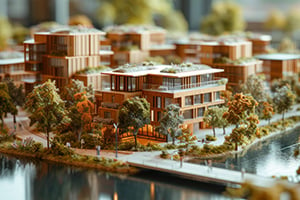 By Candice Moore Groves, R.A.,
By Candice Moore Groves, R.A.,
LEED AP BD+C, LEED AP O+M
Sustainability Maven,
Sustainable Investment Group (SIG)
If you’re visiting the beach this summer, you may notice that the community you’re visiting has a dark sky policy. The green building industry is in favor of dark skies – which reduce light pollution and save energy. In fact, there is a Leadership in Energy and Environmental Design (LEED) credit associated with this: Sustainable Sites Light Pollution Reduction.
Light pollution, if you are not familiar with this term, is light that shines up into the night sky. Have you ever noticed that the sky in cities has a “glow?” It is harder to see the stars in dense, built-up areas that you can clearly see when you’re farther away in a rural area or at a remote national park. This glow is – in a large part – due to streetlights, building lights, and lighted advertisements. This glow affects migratory patterns of birds and bats and impacts hatchling sea turtle populations.
I recently went on a family beach trip on the east coast of Florida. I was pleasantly surprised to see that the small beach town we were in posted signs regarding the sea turtle nesting season and that this built-up area with mid-rise and high-rise hotels was relatively dark. A visit to the nearby Loggerhead Marinelife Center (LMC) during our visit provided information on how to be sensitive to the turtle hatchlings who are naturally drawn to the moonlight reflecting off of the surface of the ocean. Light pollution may confuse the hatchlings who head inland toward the artificial light instead of towards the moonlight on the ocean. Coastal developers and building owners should visit the International Dark Sky Association’s website, here for information on ways to incorporate turtle-friendly lighting strategies into upcoming new construction or retrofit projects.
The mission of the Marinelife Center is to promote conservation of Florida’s coastal ecosystems with a focus on threatened and endangered sea turtles. The highlight of our visit was – of course – seeing the sea turtles that are being rehabilitated in the outdoor tanks in the courtyard. The facility does an excellent job at educating visitors on the nesting process; my family and I learned a great deal.

Another exhibit at LMC that we thought was informative: a display on the impact that plastic bags has on sea turtles. The primary food source for sea turtles are jellyfish. Plastic bags, floating in the water bear a close resemblance to a jelly fish. This exhibit encourages the reduction of use of bags and recycling when no longer being used. SIG’s blog author Alyson Laura wrote a piece on this very problem, in an article regarding the ocean gyre titled: GYER: The Plastic Ocean.
The education mission is carried a step further in the facility’s general philosophy to educate the visitors about the facility’s sustainability efforts that were incorporated. LMC has been designated as a “Certified Florida Green Commercial Building” by the Florida Green Building Coalition (FGBC). You’ve likely heard of the LEED program that is managed by the U.S. Green Building Council (USGBC). FGBC’s program has been around since 2000 and has a similar mission, but at a local scale: to help builders, developers, contractors, local governments and consumers achieve a healthier and more environmentally sustainable future. For additional information on this green building standard, visit their website, here. If you’re considering building green in Florida – or any coastal city – call SIG for help!
 Additional Notes of interest about the inspiration for this blog post:
Additional Notes of interest about the inspiration for this blog post:
The Loggerhead Marinelife Center opened in 2007 and is located adjacent to one of the most heavily nested sea turtle beaches in the world. The facility is home to the Gordon & Patricia Gray Veterinary Hospital that treats five different types of threatened and endangered sea turtle species. Approximately 60 – 80 sea turtles are treated each year at the center and more than a thousand hatchlings come through the center each year in their program that the public actually participates in when finding stranded hatchlings. Consider adopting a sea turtle, here to help the center further their mission and help provide treatment for the “patients.” The goal for each patient is to be rehabilitated and released back to its ocean home.
Sea turtle nesting season runs from March 1st through October 31st on Florida’s east coast.
© 2015 Sustainable Investment Group (SIG). All Rights Reserved.



